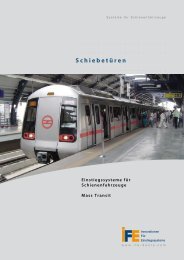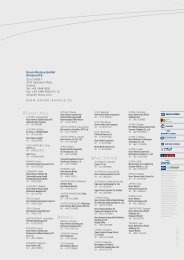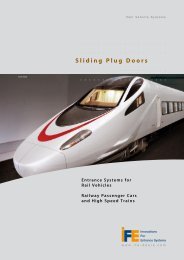Annual Report 2010 - Knorr-Bremse AG.
Annual Report 2010 - Knorr-Bremse AG.
Annual Report 2010 - Knorr-Bremse AG.
You also want an ePaper? Increase the reach of your titles
YUMPU automatically turns print PDFs into web optimized ePapers that Google loves.
66 RepoR t | RAIL Ve HICLe SYSteMS<br />
unit drivers and two for other personnel. One of each of these two types was mounted on a truck, to<br />
enable them to be used flexibly and independently of location.<br />
For the Norwegian Rail Academy Sydac also developed state-of-the-art simulators that realistically<br />
simulate the FlytoGet line in the Norwegian capital of Oslo. The Norwegian Rail Academy ordered six<br />
full cab simulators and three additional ones for operations control.<br />
<strong>2010</strong> also saw Sydac further expand its cooperation with TDS (Train Dynamic Systems), a company<br />
owned by <strong>Knorr</strong>-<strong>Bremse</strong> subsidiary New York Air Brake (NYAB). The main focus was on merging simulation<br />
of heavy-duty freight trains from North America with Sydac’s simulator technology for passenger<br />
operations.<br />
Further development of EP2002 brake control system<br />
<strong>Knorr</strong>-<strong>Bremse</strong> has launched the EP2002 Cube brake control system for metros and multiple units. Based<br />
on the proven EP2002 brake control system, the Cube features an additional integrated control module.<br />
The mechatronic system, which combines mechanical and electronic elements in a single, ultra-compact<br />
unit, now not only offers the service and emergency brake functions of EP2002 but also additional<br />
pneumatic functions for controlling the parking brake and air suspension. As a result there is no longer<br />
any need for an additional, separate control panel.<br />
In the past, auxiliary functions such as air treatment or parking brake control have been installed in<br />
brake control modules in sub-frames or on equipment panels. This is where the EP2002 Cube makes a<br />
real difference. The Cube is basically a three-dimensional aluminum block with no active functional elements<br />
of its own that fills the roles of the conventional EP2002 assembly subframe, the connector block<br />
and the piping, effectively making it a three-dimensional multifunctional component. All of the components<br />
required for the above functions are attached to the Cube. The multiple air lines encased<br />
within the aluminum block mean that except for the compressed air feed pipe and the lines to the<br />
mechanical brake components, air spring components, and reservoirs, all of the piping in the vehicle<br />
can be dispensed with. Even then, the installation envelope of the Cube is no larger than the crosssection<br />
of an average air reservoir. This simplifies integration of the brake control system, enabling it to<br />
be installed beneath the car within a length of just 400 millimeters.<br />
Advantages like these have greatly accelerated the market penetration of the new EP2002 Cube. By the<br />
end of the year under review some 700 units had already been installed in metro projects in China.<br />
New E3D door system<br />
During the year under review, <strong>Knorr</strong>-<strong>Bremse</strong>’s subsidiary IFE developed a new door system for trains<br />
travelling at speeds up to 300 km/h. E3D is an electrically operated single-leaf door system that combines<br />
the familiar E3 and DET door systems. It is supplied almost completely pre-assembled and features<br />
a compact installation envelope and easy maintenance.


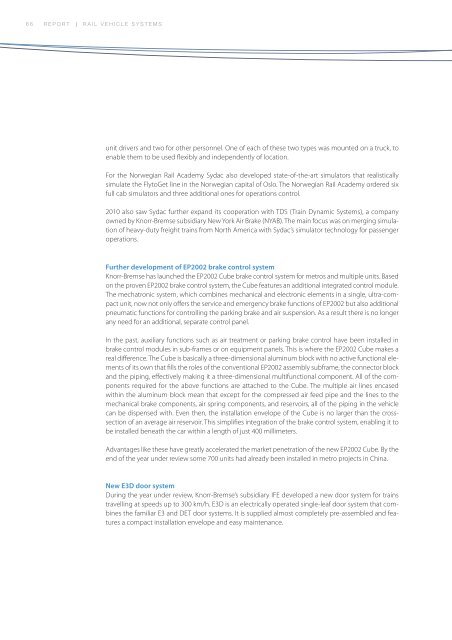



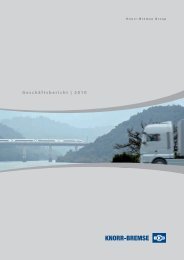
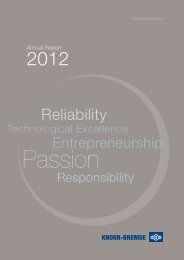
![Geschäftsbericht 2012 [PDF, 13 MB] - Zelisko](https://img.yumpu.com/22524926/1/184x260/geschaftsbericht-2012-pdf-13-mb-zelisko.jpg?quality=85)

